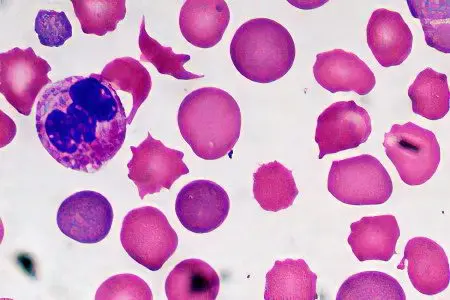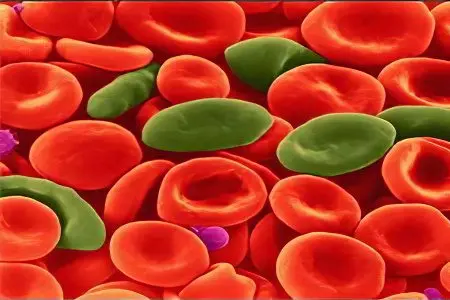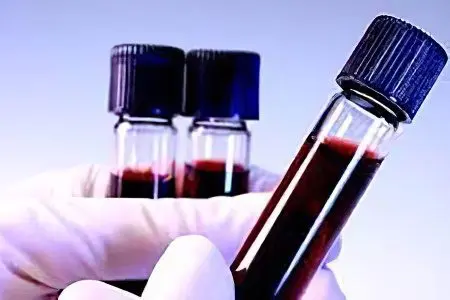Contents

Megaloblastic anemia is one of the varieties of anemia, characterized by disorders in the hematopoietic system in which red blood cells begin to form in the bone marrow, which have a low structure. Megaloblastic anemia is also called B12 deficiency anemia.
In the general structure of anemia, megaloblastic anemia occurs in 9-12% of cases. It develops with the same frequency in both men and women, but older people suffer from pathology more often.
Without treatment, megaloblastic anemia will progress and lead to serious consequences for human health.
Causes of megaloblastic anemia

Megaloblastic anemia develops due to a lack of folic acid (vitamin B9) and vitamin B12 (cyanocobalamin) in the body.
The following factors can lead to a decrease in the level of vitamin B9:
Errors in nutrition, when a person sharply restricts himself in food.
Violation of the absorption of vitamin B9 in the intestine. This occurs with various pathologies of the digestive tract, for example, enteritis, colitis, celiac disease.
Transferred resection of the stomach or intestines.
Certain periods in a person’s life when the need for folic acid increases dramatically, for example, the period of gestation and the period of breastfeeding.
Some types of hemolytic anemias.
exfoliative dermatitis.
Parasitic invasions, in particular, diphyllobothriasis.
Carrying out extrarenal blood purification.
Liver pathologies: hepatitis and cirrhosis.
Chronic inflammation of the pancreas.
Alcoholism.
Taking certain medications: oral hormonal contraceptives, anticonvulsants, etc.
Vitamin B12 deficiency in the body can develop for the following reasons:
Refusal of food of animal origin and commitment to vegetarianism.
Oncological lesions of the gastric wall or the presence of polyps in the stomach.
Transferred resection of the stomach and small intestine.
Ulcerogenic pancreatic adenoma.
Carrying a child and breastfeeding him.
Celiac disease.
Crohn’s disease.
Liver pathologies: hepatitis and cirrhosis.
Transcobalamin II deficiency.
Vitamin B12 and vitamin B9 are directly involved in the formation of human DNA and RNA, and the cells of the red bone marrow and mucous membranes of the digestive system will suffer first of all. They are the ones that divide the fastest in the body. The precursor cells of erythrocytes in this pathology are not able to make a full transition to a more mature form. However, they do not die, their cytoplasm continues to grow and develop. As a result, large defective erythrocytes begin to circulate in the blood, which experts call megaloblasts.
Vitamin B12 enters the body with food. Its main source is animal products. In the stomach, it interacts with a special substance called gastromucoprotein. With it, vitamin B12 forms a complex compound and in such a bundle penetrates into the small intestine, where it is absorbed into the blood. Every day, a healthy person should receive 3 to 7 micrograms of vitamin B12. In the liver, normally, it contains from 3 to 5 mg – this is the depot of cyanocobalamin. The body should receive more folic acid per day – about 100 mcg. Every day (with a standard diet) a person consumes from 300 to 750 micrograms of folic acid. The depot of the body contains about 5-10 mg of this substance.
Vitamin B12 in its composition contains 2 coenzymes. If there is a deficiency of the first coenzyme, then DNA is not able to form normally, which leads to a failure in the production of erythroid cells and the appearance of megaloblasts in the blood. The process of synthesis of leukocytes and platelets also suffers, but not to the same extent as erythrocytes.
In addition, the lack of the first coenzyme prevents the body from producing the amino acid (methionine), which is part of the myelin sheaths that cover the nerve trunks and cells. Therefore, the functioning of the nervous system as a whole is disrupted.
Deficiency of the second coenzyme, which is part of vitamin B12, leads to the fact that the metabolism of fatty acids is disturbed in the body. Toxins begin to accumulate in it, which affect the cells of the spinal cord. This pathology is called funicular myelosis.
Symptoms of megaloblastic anemia

Most often, megaloblastic anemia develops due to a lack of vitamin B12 in the body. All the symptoms of this disorder are grouped into four large groups:
Symptoms associated with disorders in the functioning of the digestive system. With megaloblastic anemia, atrophic changes occur in the mucous membranes of the stomach and intestines, and there is also a lack of production of enzymes necessary for normal digestion of food. This leads to the fact that patients present the following complaints:
Lack of desire to eat.
Aversion to meat dishes.
Pain in the tongue, taste distortion. The tongue may become bright in color, covered with a shiny film (Gunther’s atrophic glossitis).
Complaints of nausea, which can occasionally result in vomiting.
Stool disorders (diarrhea).
Symptoms of funicular myelosis.
Headache.
Sensitivity disorders in the form of “crawling on the skin”, tingling of the skin, etc.
Sensation of coldness in the limbs, deterioration of their sensitivity.
Changes in a person’s gait.
Decreased muscle strength, and with severe anemia, the patient develops paralysis.
Circular-hypoxic syndrome. Its manifestations:
Feeling of constant weakness.
Increased fatigue.
The appearance of shortness of breath. First, it occurs against the background of physical activity, and then begins to bother, even when a person is resting.
Cardiopalmus.
Pain in the chest (heart pain).
The skin becomes unnaturally pale, or even icteric.
Symptoms caused by disturbances in the functioning of the nervous system:
A person’s irritability increases, he becomes very nervous.
Hallucinations may occur.
Seizures occur periodically.
Mental faculties deteriorate.
At the beginning of the development of anemia, a person may not present any complaints, since there will be no pathological symptoms during this period. Perhaps a slight deterioration in well-being, fatigue and mild dyspepsia. As a rule, patients do not visit doctors during this period. Although already at this time it is enough to do a blood test to identify developing anemia.
As the disease progresses, the symptoms begin to gain in strength. If a person already has any pathologies of a chronic course, then their clinic will be aggravated. For example, this is true for angina pectoris and arrhythmias. Also on the legs and arms, and even on the face, swelling appears.
In old age, anemia most often has a latent course. Patients do not indicate to the doctor that they are not feeling well, which makes diagnosis difficult.
How to detect megaloblastic anemia?

The search for the correct diagnosis begins with the collection of an anamnesis and listening to the patient’s complaints. An experienced doctor can already suspect anemia at this stage.
The patient examination includes the following steps:
Inspection of the skin: they are pale, sometimes with a yellowish tint (“parchment skin”).
Tongue red and shiny, sore and slightly swollen.
When listening to the heartbeat, systolic murmurs and tachycardia are diagnosed.
During palpation of the peritoneum, an enlarged spleen is palpated.
There are also signs of funicular myelosis.
The next step in the diagnosis is blood donation for clinical analysis. The results of the study will reveal a decrease in the number of red blood cells and hemoglobin, the color index of blood exceeds 1,1. Sometimes anemia is accompanied by thrombopenia and leukopenia. Macrocytes and megaloblasts are also visualized in the blood. Blood cells change their normal shape and size. Another sign of megaloblastic anemia is the presence of Kebbot’s rings and Jolly’s bodies in the blood. The level of reticulocytes is lowered.
There is also a deficiency of folic acid and vitamin B12 in the serum part of the blood. Serum iron values remain within the normal range or increase, which is caused by accelerated destruction of red blood cells. This fact also provokes a jump in bilirubin in the blood.
The study of the bone marrow, which is obtained by performing a sternal puncture, allows you to clarify the diagnosis. The study must be carried out in advance, that is, before the start of treatment. The fact is that taking vitamin B12 in 1-2 days will return the composition of the bone marrow to normal, and the signs of megaloblastic anemia will be stopped.
The vast majority of patients are diagnosed with lesions of the mucous membranes of the digestive system with their atrophic changes. In the stomach, the production of hydrochloric acid decreases.
Thus, the diagnosis of megaloblastic anemia consists of 3 main stages:
Blood sampling for general analysis.
Performing a bone marrow puncture.
Taking an anamnesis and studying the state of the digestive system, including the liver, spleen, etc.
Be sure to exclude the fact that the patient has a parasitic invasion.
How to treat?

Treatment should be based on the causes that led to the development of anemia. It may be necessary to take antiparasitic drugs, eliminate polyps or other neoplasms of the digestive system, treat intestinal diseases, place the patient in a drug treatment clinic if he suffers from alcohol addiction, etc.
Be sure to adjust the diet of the patient. It is necessary to introduce meat, liver, dairy products, fresh vegetables and fruits into its menu.
To eliminate vitamin B12 deficiency, intramuscular or intravenous administration of cyanocobalamin is possible. From 200 to 1000 mcg of the drug can be prescribed per day, depending on the severity of anemia.
After the blood counts return to normal, the dosage of the drug can be reduced, or the frequency of injections is reduced. That is, the drug is administered 1 time in 2 days, and then 2 times in 7 days.
Improvement occurs within a week from the start of treatment, which is characterized by the development of a reticulocyte crisis. In the blood, the level of young erythrocytes increases by 2-3%. The effectiveness of the therapy is indicated by the normalization of blood counts.
Sometimes vitamin B12 is prescribed for the rest of your life, for example, with Addison-Birmer anemia. With funicular myelosis, it is required to administer to the patient daily from 800 to 100 mg of cyanocobalamin. It will be possible to reduce the dosage of the drug only after it is possible to completely rid the patient of neurological symptoms.
Sometimes megaloblastic anemia is very severe, and the patient himself may fall into a coma. In this case, he needs a transfusion of red blood cells.
When autoimmune diseases are the main reason for the development of anemia, the patient needs the introduction of glucocorticosteroids. The dosage of the drug should be minimal, and the course of treatment should be short.
With folic acid deficiency anemia, folic acid is prescribed. The daily dose is from 1 to 5 mg of the drug, depending on the severity of the disease. After all the symptoms of anemia are stopped, a course of folic acid will be required to prevent the recurrence of the disease. But the dose of the drug should be reduced.
Prophylaxis and prognosis

To prevent the development of anemia, the following recommendations must be observed:
Eat right, eating foods rich in vitamin B9 and B12.
Lead a healthy lifestyle, give up alcoholism.
Avoid situations that could lead to infection with parasites.
Treat all diseases of the digestive system in time.
As for the prognosis, with timely therapy, it is favorable and it is possible to completely get rid of anemia.
Which doctor treats megaloblastic anemia?
When the first signs of anemia appear, you should contact your local therapist. If the doctor detects such a violation, he will redirect the patient to a hematologist who will prescribe treatment. It is possible to consult with narrow specialists, including: a neurologist, an infectious disease specialist, a hepatologist, a gastroenterologist. To select an adequate diet, you should visit a nutritionist.









